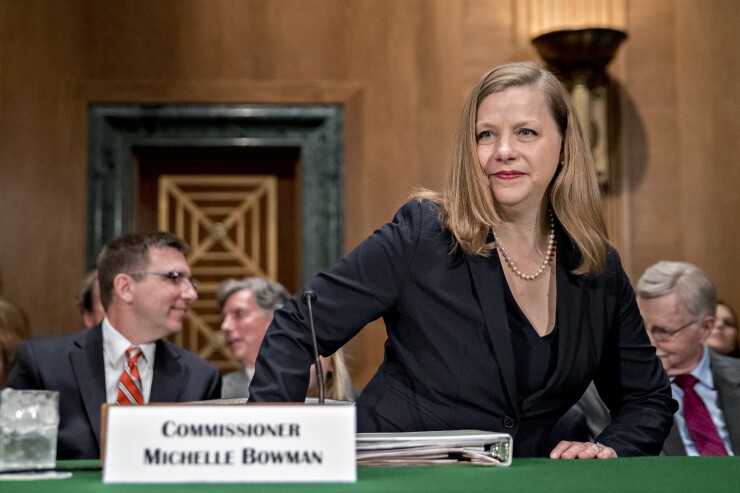
WASHINGTON — Federal Reserve Gov. Michelle Bowman criticized
"These issues — volatility, the link between
Bowman offered her critiques in remarks delivered to the Executive Council of the Banking Law Section of the Federal Bar Association and proposed looking at results across multiple years, improving transparency and re-examining some of what she believes are overlaps in regulation to upgrade stress testing at the agency.
Bowman emphasized the need for a broader approach when considering the optimal overall capital levels in the banking system. She highlighted the importance of factoring in not just risk-based and leverage capital requirements but also long-term debt obligations, a concept regulators have proposed and remains pending.
In his speech just hours before Bowman, Michael Barr, the Fed's vice chair for supervision,
Barr proposed narrowing the Basel III scope to exclude banks with $100 billion to $250 billion in assets from broader capital requirements and lowering the capital increase for larger banks from 19% to 9%. He also recommended reducing capital for operational risk and allowing banks to use internal models for market risk.
Bowman warned that this could result in excessive capital requirements, particularly for market-making and trading activities, potentially harming U.S. capital markets. She called for a careful review to ensure that these overlapping requirements are appropriately calibrated.
One issue Bowman identified is the significant change in stress-test outcomes from year to year. This unpredictability, she said, complicates long-term capital planning for banks and forces them to hold more capital than might otherwise be necessary. If a bank fails the test, it has months to comply with capital buffers, which can be particularly challenging for banks that exceed the 2.5% buffer floor.
"One solution could be to average results over multiple years, so a firm's stress capital buffer would move in smaller increments through the averaging process," she said. "Another possibility is to constrain variability in annual stress test scenario design."
Bowman also said an aspect of the stress tests known as countercyclicality contributes to volatility in stress-test results and suggested re-evaluating whether this approach is appropriate given the instability it can create.
Countercyclicality in stress tests means that when economic conditions are good, the stress scenarios for banks are more severe, acting as a balance to the natural procyclicality of risk models.
"Countercyclicality is also a driver of volatility," she said. "And we should look more closely as to whether our attempts to adjust for countercyclicality are appropriate through the lens of stress test volatility."
She said the current stress-test approach does not always reflect the range of real-world risks banks face, as seen in 2023 when rising interest rates were a key stress factor but were not incorporated into past test designs.
Bowman suggested that testing multiple scenarios would provide more valuable insights into different risks and help regulators better understand both firm-specific and broader financial stability risks. She also said stress testing should not be a rigid driver of capital levels but should instead serve as a tool to refine supervision and risk assessment.
"A more robust use of stress testing would require rationalizing the link between stress testing and capital to ensure that any change in overall calibration was driven by an intentional process that results in a reasonable policy outcome," she said. "In my view, an up-calibration of capital requirements through an expanded scenario-testing regime would not be supportable based on the underlying risks."
The Fed official raised concerns about the lack of transparency in the stress-testing process, particularly with respect to the models used by the central bank. She said improving transparency would help banks better understand the regulatory perspective and make more informed choices about capital allocation.
Bowman acknowledged the potential that increased disclosure of testing models might lead banks to adjust their activities purely to reduce stress losses and lower their capital requirements. However, she believes this concern is overstated and that transparency should be coupled with ongoing adjustments to prevent such gaming.
"Greater disclosure and transparency should be accompanied by a careful review of how firms incorporate and use any additional information," she said. "To the extent that gaming activity is identified, further changes to the test design may be appropriate."
Bowman also noted what she saw as potential to double-count risks for bank capital purposes across multiple requirements. She singled out the market risk and operational risk rules — under consideration as part of the Basel III endgame capital reforms — as potentially duplicating requirements in the stress testing framework, specifically the "global market shock" component.
"In my view, there are strong indications that as currently formulated, the combination of these requirements would result in an excessive calibration of risk-weighted assets for market making and trading activities," she said. "We need to ensure that the risks captured and methodologies underpinning these distinct requirements do not lead to an over-calibration of capital requirements for activities that support the important role of U.S. capital markets in the global economy."






